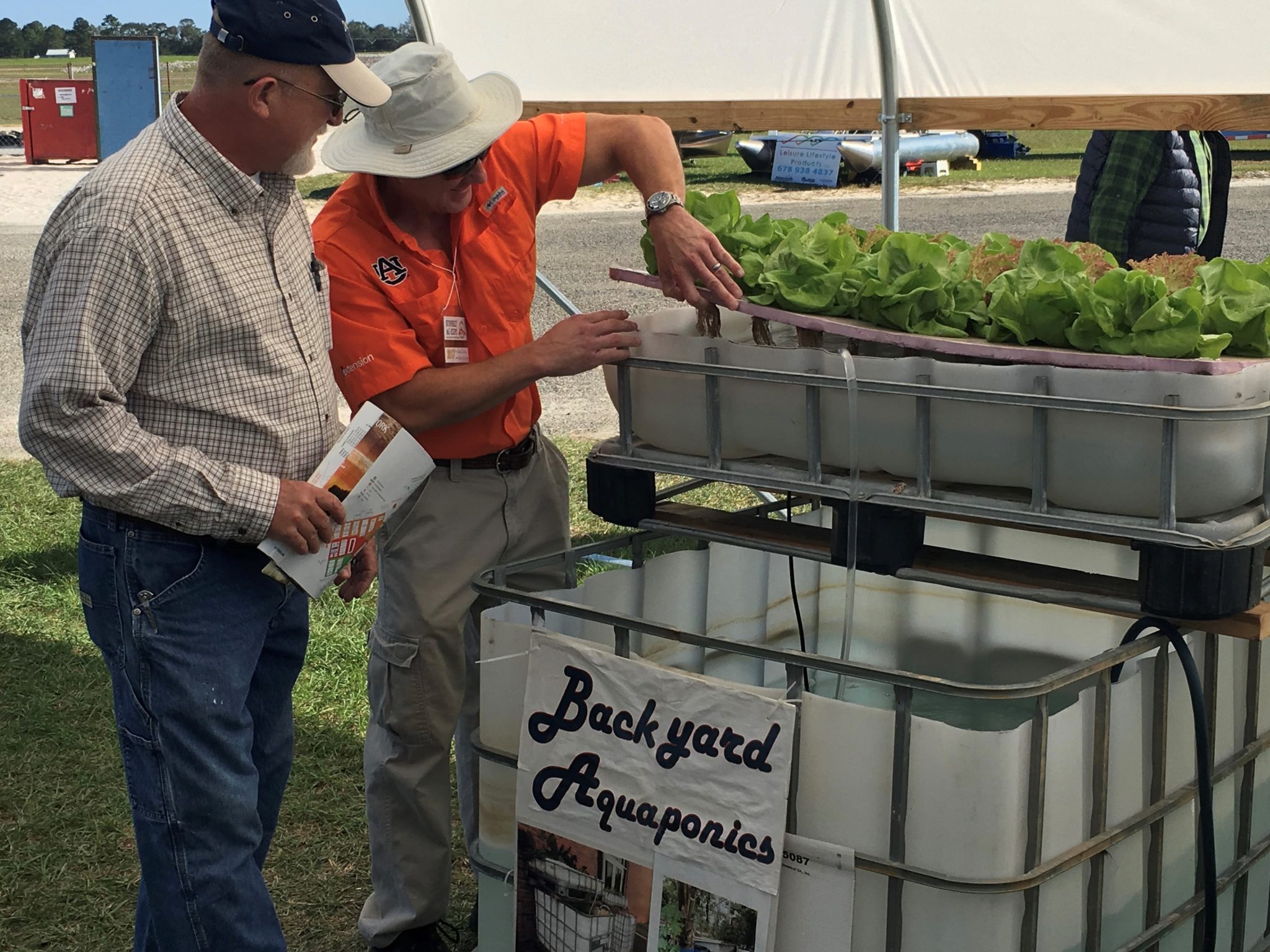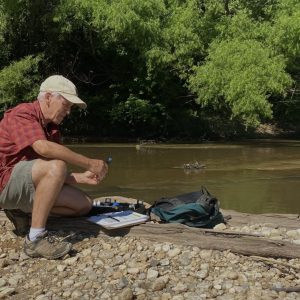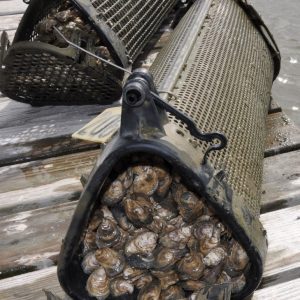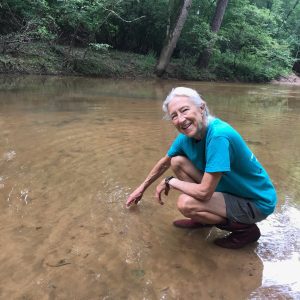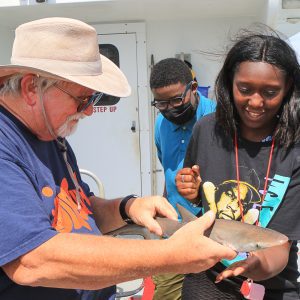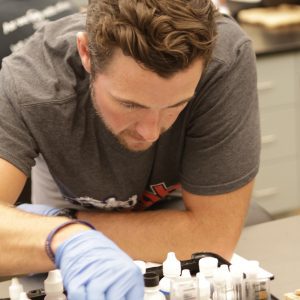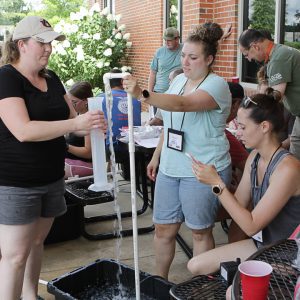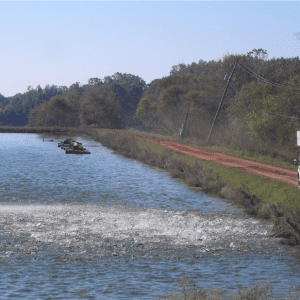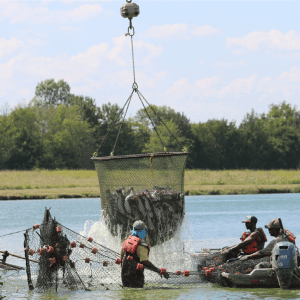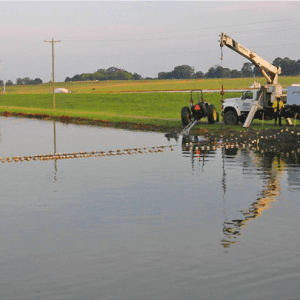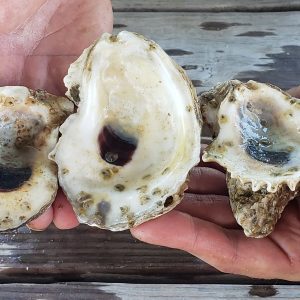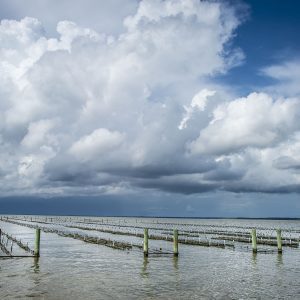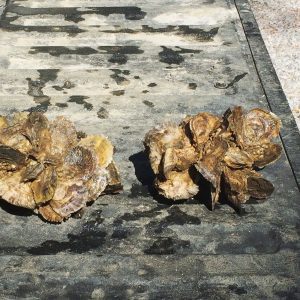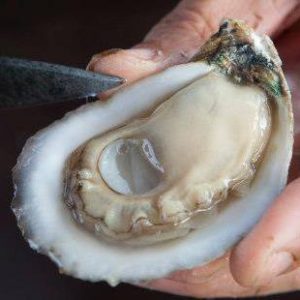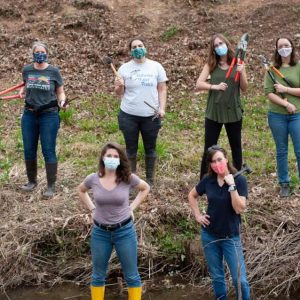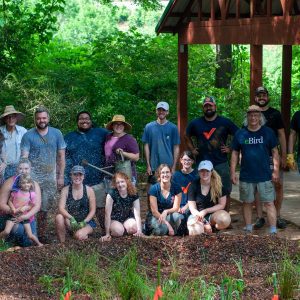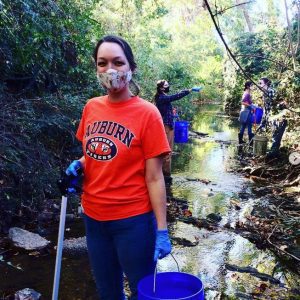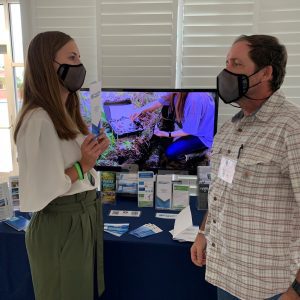Aquaculture

The mission of the Alabama Extension Aquatic Resources team is to provide relevant, science-based information to help Alabama’s residents make informed natural resource–related management decisions.
Alabama is a water-rich state with more than 77,000 miles of streams, 3.6 million acres of wetlands, 60 miles of Gulf of Mexico coastline, the most extensive artificial reef system in the United States, and 560,000 acres of lakes, ponds, and reservoirs. Alabama’s waters are also among the most biologically diverse in North America with more than 300 species of freshwater fishes as well as diverse marine fishes and invertebrates, aquatic plants, reptiles, and amphibians. These rich water resources are used for drinking and other household uses, hydroelectric power, irrigation, aquaculture, commercial and recreational fisheries, transportation, industrial uses, and recreation. Demands will continue to increase as human populations expand and development increases.
The Aquatic Resources Program Team provides science-based Extension programming in the areas of aquaculture (freshwater and marine), private pond and lake management, coastal resources, commercial and recreational fisheries, aquatic resource conservation, and aquatic resources K–12 curriculum development. Our team consists of statewide and area specialists located strategically around the state as well as natural resource regional agents and county coordinators. Together, we provide educational programming, workshops, seminars, and diagnostic services with an emphasis on environmental stewardship, best management practices, and economic viability.
This report groups projects into three program areas: Inland Aquaculture, Coastal Programs, and Aquatic Natural Resources.
Inland Aquaculture
Aquaculture and Aquaponics Education
Project Leader: David Cline
Extension Collaborators: P. J. Waters, Terry Hanson
Background: Aquaculture, like agriculture, is a complex subject with numerous facets for study in educational programs. Many secondary agriculture and science teachers have realized this and integrated aquaculture into their curricula. Aquaculture is an excellent teaching tool because it easily integrates many disciplines including biology, chemistry, economics, math, and physics. Growing fish, aquatic plants, and other living things in the classroom creates a living laboratory and promotes daily hands-on experiences that enrich the learning environment. It makes learning practical, experiential, and enjoyable for teachers and students. The issue is that very few teachers have any formal training in aquaculture or aquaponics and are unprepared to teach these classes diminishing the potential impact.
There is also a need to provide continuing education to aquaculture practitioners and the public. Farmers need the latest aquaculture information to help make on-farm business decisions to optimize their operations or consider alternative production strategies. The public needs general information to understand aquaculture and the benefits it provides to Alabama and society in general.
Approach: This project included multiple approaches to provide aquaculture training and education opportunities to teachers and students, fish farmers, and the public. Techniques included workshops (4), tours and presentations (66), webinars (12), and online videos (66).
Number of Participants: 3,501 in-person; 140,471 online (9,250 hours)
Audience Diversity: 52% male, 48% female, 70% White, 30% Black, 10% Hispanic
Evaluation Techniques: Workshop surveys, tour attendee surveys, video views
Direct Impacts: $950,086 ($10,946 worth of teaching materials provided; $9,140 tour fees waived; $925,000 worth of consulting fees avoided)
Return on Investment: 19:1
($950,086 impact/$50,00 estimated costs)
Inland Production Aquaculture
Extension Collaborators: Luke Roy, Anita Kelly, Terry Hanson, David Cline
Background: US farm-raised catfish are the seventh most popular seafood item consumed in the United States. Americans eat 19.2 pounds of fish and seafood per person per year, and each American eats 0.55 pounds of US farm-raised catfish annually.
Alabama ranks sixth in US aquaculture (including catfish) sales at $95 million. In 2021, the US farm-raised catfish industry produced 307 million pounds of catfish from 58,130 acres of water. Alabama produced 91 million pounds from 15,968 acres representing 28% of all catfish produced in the United States. The average Alabama catfish production is 5,807 pounds per acre per year.
Two catfish processing plants are located in western Alabama: one in Uniontown (Perry County) and one in Eutaw (Greene County). Two catfish feed mills are in western Alabama: Uniontown (Perry County) and Demopolis (Marengo County). A recently completed Southern Regional Aquaculture Center Economic Impact study of the US farm-raised catfish industry stated that Alabama’s catfish industry had a total economic impact of $496 million to the state’s economy, added 2,109 jobs, and generated $20.5 million in taxes.
The Alabama catfish industry faces serious issues. In the early 2000s, more than 25,000 water acres were in production in Alabama, including approximately 250 catfish farms in western Alabama and four processors. By 2021, this had declined to 77 farms; 15,968 water acres; and two catfish processors.
This decline is due to several issues.
- Feed prices: A dramatic surge in feed prices from $201 per ton in 2000 to $491 per ton in 2021.
- Competition: Inexpensive imports (mainly from Vietnam and China) flooded the US marketplace with alternative catfish-like products, such as tra, swai, and basa. Tilapia has also become another inexpensive, competitive import.
- Other economic forces: The COVID-19 pandemic has disrupted many industry supply chains, and catfish is one of them. Increases in freight costs, lack of trucking, higher fuel prices, inflation, higher feed ingredient prices, and lack of available labor have affected catfish production, processing, and feed manufacturing. These factors, along with increasing, inexpensive imports have significantly reduced the size of the catfish industry in Alabama and the rest of the United States.
- Disease losses: Annual production losses have been greater than $12 million annually over the last 10 years due to bacterial diseases, representing the biggest challenge to the Alabama catfish industry. Losses have been particularly heavy due to a virulent strain of Aeromonas hydrophila bacteria introduced from China. However, there was an 8% decrease in losses in 2021 compared to 2020. Much of this improvement could be due to disease diagnostic and educational efforts of the Alabama Fish Farming Center. Educational and research efforts related to antibiotic resistance and the positive impacts of pond renovation including reductions in bacterial disease loads compared to nonrenovated ponds may have contributed to the reduced losses.
- Fish size: Excessive amounts of large fish that are above-market size and too big for the processor to accept have been on the rise. Solutions to this “big fish” issue have been developed based on producer survey information, including additional reseining of a pond after initial harvest, using rotenone after a pond has been completely harvested of premium-sized fish, and draining a pond to renovate the bottom into a smooth surface to improve seining efficiency.
Pond-to-Plate Project
Project Leaders: Terry Hanson, Luke Roy, Anita Kelly, David Cline
Background: The Pond-to-Plate Project has been working to solve problems facing the Alabama and US farm-raised catfish industries. Broadly, these goals seek to improve production efficiency, product quality, consistency, and competitiveness of Alabama aquaculture throughout the value stream (hatchery, fingerlings, grow-out, flavor checking, harvesting, processing, distribution, consumer, retail outlets). The ultimate goal of the Pond-to-Plate project is to make catfish production a competitive modern livestock industry. Over the life of the project, we have researched and provided solutions through projects investigating yield verification, deployment of a hybrid grader seine, in-pond raceway systems, fillet color (yellowness/ redness), “big fish” reduction, columnaris-caused mortalities, LEAN manufacturing rapid improvement events in processing, price-quantity gaps, retail outlet needs, consumer demand, retail scanner analysis, and traceability. In the final products and production process, the mechanism that will guide the industry toward modernity and profitability is a set of standards based on best management practices (BMP) and standard operating procedures (SOP) that all participants in the value stream should apply.
Approach: Several approaches were used to elicit input and provide information to catfish producers, processors, feed mills, and other value chain participants. Techniques used included conducting listening sessions and need assessment, developing informational Extension web articles, delivering monthly catfish production and feed delivery reports, delivering industry update presentations, conducting workshops, developing online videos, and delivering research results to end users.
Number of Participants: 7,090
Audience Diversity: 76% Male, 24% Female; 73% White, 17% Black, 7% Hispanic, 3% Asian
Evaluation Techniques: Use evaluation surveys at the end of each meeting, presentation, and workshop to track the numbers of producers, feed mill managers, and processors aware of BMPs and the number practicing such standards.
Direct Impact:
- $1,063,500 (using a conservative estimate of $150 per contact based on cost for professional assistance).
- Total grant funding for this project = $242,859.
Return on Investment: 4.4:1
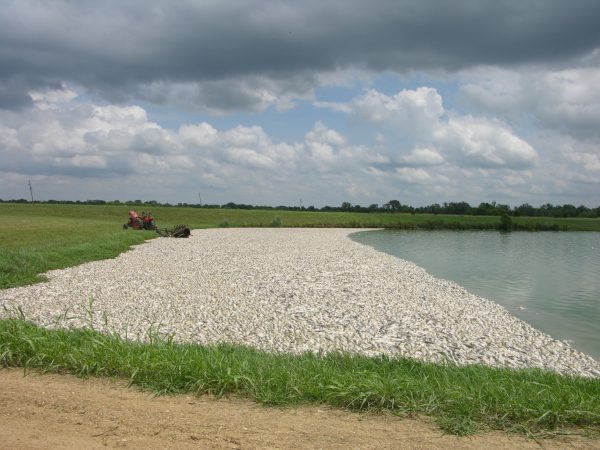 Aquatic Diseases
Aquatic Diseases
Project Leaders: Anita Kelly, Luke Roy, Terry Hanson
Non-Extension Collaborators: Tim Bruce
Background: Channel catfish and hybrid catfish are collectively called catfish in the United States. This is the largest aquaculture sector in the country, and Alabama ranks second in annual catfish production. There is also a region in which producers have access to low- salinity wells, which a few producers use to raise marine shrimp. The Alabama Fish Farming Center (AFFC), located in the heart of the state’s catfish and low-salinity aquaculture region, provides diagnostic, research, and Extension programs to producers in Alabama. Producers either bring sick fish and water samples to AFFC or personnel visit the farm to diagnose diseases in the mobile lab. In 2021, the Alabama Fish Farming Center provided 141 farm visits to diagnose catfish and shrimp diseases and diagnosed another 198 disease cases. In 2021, 6.3 million pounds of catfish losses to disease occurred in West Alabama. These losses were 8% lower than those that occurred in 2020.
The primary bacterial diseases included virulent Aeromonas hydrophila, Flavobacterium columnare, and Edwardsiella ictaluri, while additional parasitic losses were due to proliferative gill disease and water quality issues, including low-dissolved oxygen and algal toxin releases. The estimated dollar damage loss due to diseases and disease-related problems in farm-raised catfish in Alabama in 2021 was $13.5 million. Aquaculture ponds in west Alabama are watershed ponds and are, therefore, not renovated regularly. Some ponds have not been renovated for more than 30 years. Aquatic diseases are rising, and many diseases now occur outside their optimal temperatures. To address producers’ concerns regarding the increase in disease incidents, we measured the number of disease organisms in several ponds—some renovated and others not. We found several antibiotic-resistant strains of bacteria in the ponds, leading to antibiotic resistance in disease organisms that are devastating to the aquaculture industry. We held an antibiotic- resistance workshop for aquaculture producers in Alabama to disseminate this information. As a result, 83% of the producers indicated that they have changed how they administer antibiotics to fish. Overall, a positive impact has been achieved by teaching producers to identify diseases and educating them on early diagnosis, prevention, and proper antibiotic treatments. This industry employs more than 2,600 people in the Black Belt region of west Alabama, an economically depressed area.
Number of Participants: 3,935
Audience Diversity: 92% Male, 8% Female; 92% White, 4% Black, 2% Hispanic, 1% Asian
Conservative Direct Impact Estimate:
- $640,080 savings in catfish losses (8% reduction in catfish losses due to producers’ change in behavior in the past year as a result of this team’s diagnostic work and antibiotic workshops (504,000 lb. x $1.27/lb.).
- Project costs of $33,900 (for 141 farm visits plus 198 AFFC diagnostic cases x $100 per case).
Return on Investment: 19:1
Coastal Programs
Oyster Gardening on the Northern Gulf Coast
Project Leader: P. J. Waters
Background: More than 85% of oyster reefs have been lost worldwide. The Northern Gulf of Mexico is home to one of the last regions where restorative efforts can be effective. Residents of the region possess strong cultural connections to the bays and estuaries in the forms of culinary, recreational, and business interests. Oyster reefs of this region are the primary habitat for other species of importance to the way of life in these areas as well as playing a primary role in water quality maintenance. Oyster gardening programs facilitate a connection between residents and these ecological habitats central to their way of life on the coast. In 2021, oyster gardening programs coordinated by Alabama Extension saw its citizen scientists raise nearly 65,000 advanced stocker oysters for replanting on up to 3.2 acres of reef. The economic value of this habitat potential is $75,703.
Collaborating Agencies: Alabama Department of Public Health, Alabama Marine Resources, Mississippi- Alabama Sea Grant Consortium, Auburn University Shellfish Laboratory, Little Lagoon Preservation Society, Mississippi Department of Marine Resources
Number of Participants: 213 gardeners on the Gulf Coast of Alabama and Mississippi
Number of Oysters Produced: 65,000
Value of Habitat Potential: $75,904
Project Diversity: Approximated a 1:1 male:female Non-Student Volunteer Hours: 3,829
Value of Volunteer Hours: $109,279
Total Program Return: $184,982
Return on Investment: 8.68:1
Off-Bottom Oyster Farming in Alabama
Project Leaders: Russell Grice, Bill Walton
Extension Collaborators: Andrea Tarnecki
Background: Off-bottom oyster farming, common in other parts of the country, cultures oysters typically using hatchery-reared single set oysters instead of clumps of oysters normally found in the wild. They are grown to be sold commercially as a premium, high-value product. To support the development and expansion of this industry, applied research is conducted to improve profitability, solve production issues, enhance product safety and minimize environmental impacts. Support is provided through site visits, technical support, a monthly newsletter, virtual symposia, workshops, online tools, and guest speakers.
Collaborating Agencies: Alabama Marine Resources Division, Dauphin Island Sea Lab, Mississippi Department of Marine Resources, Mississippi- Alabama Sea Grant Consortium, Alabama Department of Public Health
Number of Participants: 687
Audience Diversity: 61% Male, 39% Female; 83% White, 15% Black
Evaluation Techniques: Surveys of production and workshop assessment
Conservative Direct Impact Estimate:
Oyster production is always reported for the prior calendar year. Despite challenges due to storms and changing market conditions, the Alabama off-bottom oyster harvest was valued conservatively at $2.9 million, accomplished by at least 11 commercial operations using approximately 30 acres of submerged lands. These farms are estimated to support at least 20 full- time jobs and 10 part-time positions.
Return on Investment: 15:1
Key Project Resources: On the Lid monthly newsletter, regional symposium, online resources
Coastal Community Resilience
Project Leader: Jody Thompson
 Background: Coastal areas are increasingly under social, economic, and ecological impacts from increasing human population and more frequent and severe tropical activity stemming from changing climate and sea level rise. Alabama Extension has worked with external partners through the Gulf of Mexico Alliance to develop tools and workshops to meet the needs of resilience practitioners both directly and indirectly near the coast.
Background: Coastal areas are increasingly under social, economic, and ecological impacts from increasing human population and more frequent and severe tropical activity stemming from changing climate and sea level rise. Alabama Extension has worked with external partners through the Gulf of Mexico Alliance to develop tools and workshops to meet the needs of resilience practitioners both directly and indirectly near the coast.
Using external funding, Extension developed Plan for It!, a digital game for use in outreach and education settings to improve support for resilience decisions at the local level. Although many resources exist that increase knowledge of the need for resilience actions in the Gulf, many are not interactive, are at a high education level, or require Internet access. A gap in educational products exists for interactive educational resilience tools at a lower, introductory knowledge level, particularly that can occur in a short time without access to the Internet, which is lacking in many rural areas.
Plan for It! puts the player in the role of the community planner of a fictional and generic coastal town leading up to the next hurricane season, asking them to make real-life resilience decisions in risk-reward scenarios to better prepare their town for the upcoming storm season. Game play involves fictional scenarios and real-life decision points that mimic those encountered in a real-world community situation and emphasizes the implementation of green infrastructure and mitigation of storm water impacts. Game play ends after a category 3 storm event. Animations reflect player decisions to fictionalized but real-world scenarios over an 80-day time line. Players receive real-time feedback through scoring and rewards or consequences during game play.
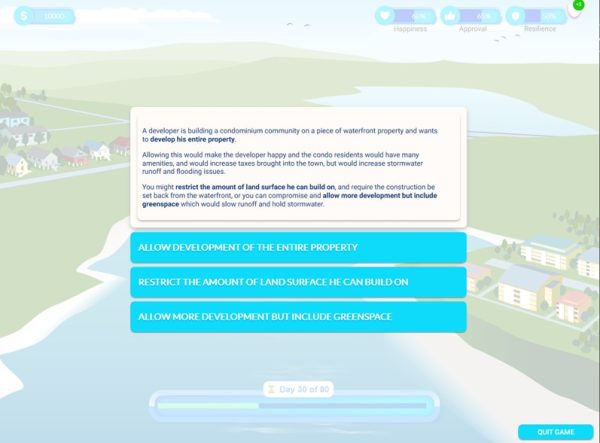 For use by fifth-graders through adults, Plan for It! target audiences include the general public, municipal board members, and local decision-makers. It is available for use with no Internet connection once it has been downloaded and game play is short, making it ideal for all outreach settings. Plan for It! puts the player in the role of coastal planner, asking them to make real-life resilience decisions in risk/reward scenarios. After playing this short game, individuals have a better understanding of the role of resilience measures and the trade-offs in the planning process. It is appropriate for use in a multitude of outreach and educational settings and can lead to further discussion and conversation. Access the game by scanning the QR code below or visit https://www.aces.edu/go/PlanForIt.
For use by fifth-graders through adults, Plan for It! target audiences include the general public, municipal board members, and local decision-makers. It is available for use with no Internet connection once it has been downloaded and game play is short, making it ideal for all outreach settings. Plan for It! puts the player in the role of coastal planner, asking them to make real-life resilience decisions in risk/reward scenarios. After playing this short game, individuals have a better understanding of the role of resilience measures and the trade-offs in the planning process. It is appropriate for use in a multitude of outreach and educational settings and can lead to further discussion and conversation. Access the game by scanning the QR code below or visit https://www.aces.edu/go/PlanForIt.
Because of the pandemic, in-person workshops were limited. Extension partnered with the Gulf of Mexico Alliance and Gulf Climate and Resilience Community of Practice to provide webinars to address identified needs of community resilience practitioners. Two webinars were held. The first showcased a home elevation project undertaken by the City of Key West, Florida. The second showcased a guest speaker through the Extension Disaster Education Network and addressed wellness and connectedness in tough times. Although this topic is not a typical one to tackle through resilience education, a need was identified: many Gulf Extension and outreach practitioners are feeling the emotional impacts of repeated exposure to severe hurricanes while still serving their communities and assisting in recovery. Both webinars were well received, and webinars continue until group in-person meetings can begin later in 2022.
Number of Participants: 85 participants in two webinars
Target Audience: The resilience game is appropriate for fifth grade and above and is targeted to the general public. The webinars are targeted at decision-makers in coastal communities, for example, floodplain managers, building inspectors, elected officials, and planners.
Evaluation Techniques: The Plan for It! electronic game is currently in evaluation, determined by usage and pre- and post-testing. The Climate Community of Practice webinars were evaluated using a standard post- event survey.
Coastal Resilience to Oil Spills
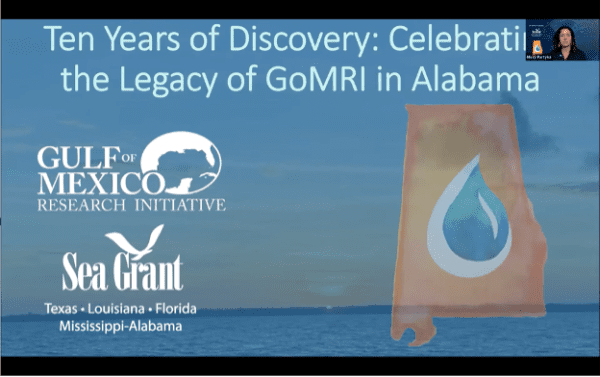 Project Leader: Melissa Partyka
Project Leader: Melissa Partyka
Background: Following the 2010 Deepwater Horizon oil spill, the Gulf of Mexico Research Initiative (GoMRI) funded programs at the four Gulf Sea Grant college programs to create a regional outreach team dedicated to sharing peer-reviewed oil spill science and to serving as a bridge to those looking for answers to oil spill questions. The goal was to find unique ways to share oil spill science with specific stakeholders, such as commercial fishers or oil spill responders, who might not access it otherwise.
More than ten years after the Deepwater Horizon oil spill, questions continue to be asked about the potential impacts on humans from spilled oil and chemical dispersants used in response to spills. Perceptions of risk to community members as well as limited access to data on human health impacts have led to an increased demand for high-quality, science-based information from trusted sources.
During the eight-year life of the team, it delivered science via outreach publications, small-group workshops, stakeholder-driven input sessions, in-person presentations, and larger seminar events that allowed leading oil spill scientists to present their own research and take questions from the audience.
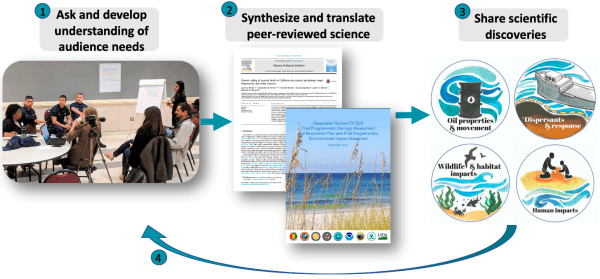 In 2021, team members produced 15 peer-reviewed outreach bulletins on topics such as human impacts, wildlife impacts, oil spill modeling, oil spill response, and more. Specialists worded these publications in such a way that someone with little science background could understand their significance. Between May and November 2021, these documents were viewed online more than 8,000 times.
In 2021, team members produced 15 peer-reviewed outreach bulletins on topics such as human impacts, wildlife impacts, oil spill modeling, oil spill response, and more. Specialists worded these publications in such a way that someone with little science background could understand their significance. Between May and November 2021, these documents were viewed online more than 8,000 times.
At the end of 2021, the team contracted with an outside program to conduct a stakeholder review of the team’s programming and performance. More than 225 people provided feedback through the survey, which included representatives from all target audiences. Survey respondents gave the team high marks for their work: relevance (75%), credibility (92%), and quality (90%).
Collaborating Agencies: Gulf of Mexico Research Initiative (GoMRI), Gulf of Mexico Alliance, Louisiana Sea Grant, Mississippi/Alabama Sea Grant Consortium, Florida Sea Grant, Texas Sea Grant
Number of Participants: During 2021, more than 8,000 outreach publication interactions; two online seminars reaching about 500 people; and 225 program review survey respondents.
During the eight years, more than 9,000 attended oil spill presentations, and more than 8,000 participants interacted with 313 oil spill scientists over 49 live and virtual seminars with many more watching and sharing the recordings of the events at later dates.
Post-workshop/seminar surveys, input sessions, and three independent social network analyses were conducted to gauge the perceptions of the team and its members as trusted sources of information.
Aquatic Natural Resources
Recreational Fishpond Management
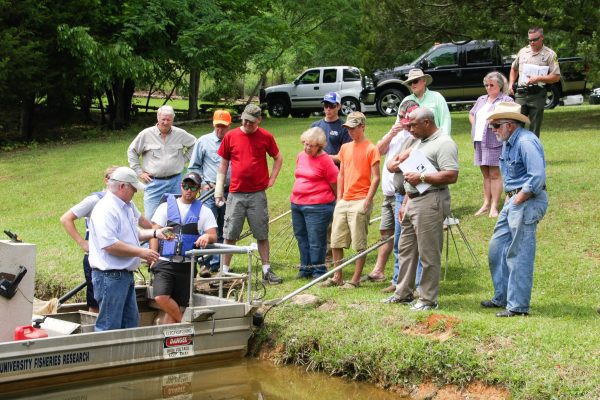 Project Leader: Russell Wright
Project Leader: Russell Wright
Extension Collaborators: P. J. Waters, Dave Cline, Bence Carter, Norman Haley, Drew Metzler, Lynn Dickinson, Luke Roy, Anita Kelly
Background: With about 250,000 small impoundments in Alabama, these primarily privately owned ponds represent some of the most important aquatic systems in the state. Ponds are used for drinking water, storm water management, irrigation, water for firefighting, livestock water, aquaculture, aesthetics, and the most common use, recreational fishing. Pond owners routinely struggle with many factors that impede efforts to reach their goals in pond management. These include aquatic weeds, fish kills, poor fish growth, structural failures such as leaks, and many others.
Educational activities, programs, and products were generated to inform pond owners and managers as well as the general public about the ecology and management of small impoundments in Alabama and throughout the southeastern United States. More than 10 specific events or public activities were conducted in 2021. Pond management workshops were led by Extension state specialists, area specialists, and natural resource regional agents. Other professionals who helped deliver these workshops included Alabama Department of Conservation and Natural Resources biologists, Natural Resource Conservation Service personnel, and private pond consultants. Other activities included sections of youth camps, field days, the Sun Belt Expo, and conventions where recreational fishpond management information was provided. Specialists and agents also offered more than 1,000 individual consultations with pond owners and managers. These included pond visits, telephone and email responses to problems, weed identification and control recommendations, and water testing for fertility assessment. Digital resources included maintaining Extension literature and lists of producers (all updated in 2021) and managing the Alabama Fisheries and Pond Management Facebook page.
Workshop and Event Participants: 1,307
Audience Diversity for Participants Providing Demographic Information: 57% Male, 43% Female; 73% White, 26% Black, 1% Other; 37% Youth, 63% Adult
Evaluation Technique and Result: No formal assessment was done in 2021. Direct consultation with pond owners provided significant impacts. Two specific situations in 2021 that demonstrate the impact of working with individuals involved the recovery of ponds from catastrophic events: a dam failure and oxygen depletion in a large pond managed for high-quality bass fishing. In both cases, the Extension specialist worked with the groups that collectively manage the ponds to restore the structure, assess the populations, and train the land managers in quality pond management all of which allowed the ponds to significantly recover without a full and very expensive restart of the pond.
Angler Education
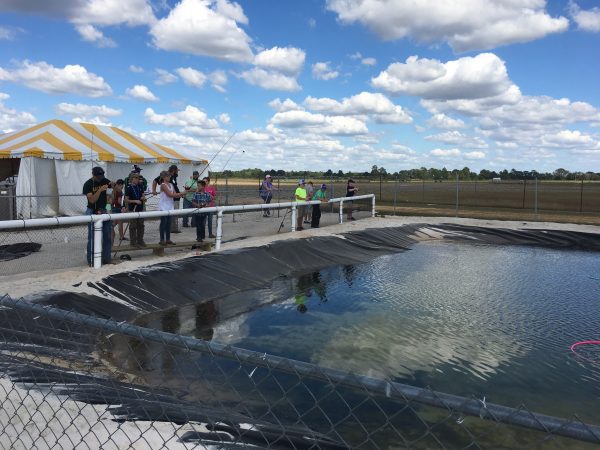 Project Leader: Russell Wright
Project Leader: Russell Wright
Extension Collaborators: Bence Carter, David Cline, Norman Haley, Emily Nichols, and the Natural Resources 4-H Team
Background: Recreational angling is an activity shared by thousands of adults and youth across the state of Alabama. In the United States, a 2016 National Survey of Fishing, Hunting, and Wildlife-Associated Recreation documented more than 35 million anglers who spent about 459 million days fishing each year. These anglers spent about $46 billion per year. A 2020 American Sportfishing Association estimate of the economic impact of recreational fishing in Alabama indicated that anglers annually spend about $310 million with a total economic impact of more than $463 million just in Alabama. We believe that angling is a healthy outdoor pastime that helps participants learn about and better appreciate our aquatic natural resources.
Unfortunately, limitations due to the COVID-19 pandemic greatly limited angler education events in 2021. One county event, a component of the Auburn University Fish Camp, and a casting experience at the Sunbelt Ag Expo in Moultrie, Georgia, were held in 2021. Angler education has been a central focus of many social media posts as well.
Workshop and Event Participants: 350 (33 in workshop events)
Audience Diversity: (Demographic data was too limited to report.)
Watershed Management
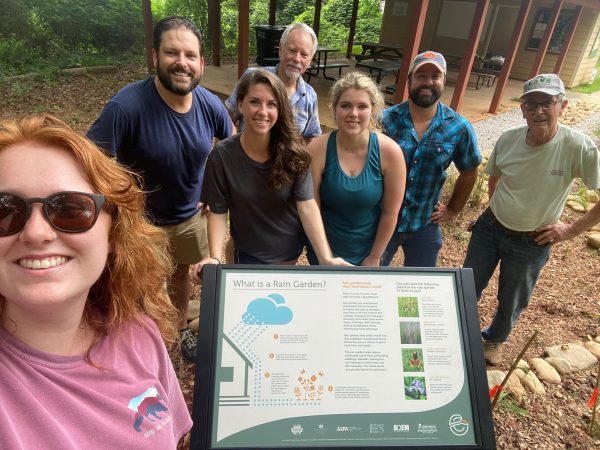 (Projects under Watershed Management are included in impact reports for both Aquatic Resources and Forestry, Wildlife, and Natural Resources)
(Projects under Watershed Management are included in impact reports for both Aquatic Resources and Forestry, Wildlife, and Natural Resources)
The Watershed Management Project develops and demonstrates management practices to enhance the development and implementation of effective watershed education, monitoring, planning, and improvement (e.g., water quality, watershed education, domestic well water). Project efforts include training in water and watershed management using demonstrations and stakeholder meetings at the watershed level, incorporation of management practices into landowner education programs, and facilitation of volunteer water monitoring workshops. Project outcomes include improved knowledge of watershed best management practices, increased adoption of watershed best management practices, and improved conditions of water resources as documented by an Alabama Water Watch volunteer water monitors.
Alabama Watershed Stewards: Taking a Watershed Approach
Project Team: Laura Bell, Eve Brantley, Mona Dominguez, Sergio Ruiz-Córdova
Background: The Alabama Watershed Stewards (AWS) is a science-based educational program that promotes healthy watersheds, increases understanding of water pollution, and provides the knowledge and tools needed to prevent and resolve local water quality problems. Initiated in 2018 by the Alabama Extension Water Program in conjunction with Alabama Water Watch, the AWS program is fully funded by the Alabama Department of Environmental Management through a Clean Water Act Section 319(h) nonpoint source grant provided by the US Environmental Protection Agency– Region 4.
The goals of the AWS program are to increase awareness, protection, and restoration of land, water, and natural resources by providing education and tools for individuals. The program increases awareness and knowledge about water issues, inspires participation in conservation programs, and promotes hands-on activities to improve and protect water and natural resources.
For this year’s project, AWS developed educational materials about watershed management, hosted watershed stewardship training events including two in-person Watershed Stewardship trainings as well as five virtual trainings, four professional development sessions around low-impact development installation practices, and one rain garden installation workshop. Workshops promoted in-depth engagement in watershed protection through nonpoint source pollution reduction.
“I learned how important it is for me, as an individual, to take action daily on keeping our water clean. I learned that I can make a difference in my household alone. I have a better understanding on how the quality of our water can be affected so now I know where I can
begin helping.”
“Truly I gained an overall much better understanding of so many different facets to watersheds, best management practices and regulatory tools and feel better prepared.”
“[I learned] the connection of the knowledge of watershed management to my local community. It was nice to learn about watersheds through the scope of something close to me as my understanding and appreciation for the subject differed greatly.”
Agency Collaborators: Alabama Department of Environmental Management, EPA Region 4.
Evaluation Technique: Knowledge assessment provided in workshops and feedback surveys.
Number of Participants: Roughly 270 people were reached by AWS programs in 2021.
Impact Estimates:
- The majority of participants in Alabama Watershed Stewards training events said they were likely to adopt water quality best management practices relevant to their work and personal lives.
- 100% experienced a change in knowledge after AWS training events (18% average knowledge increase after training).
- 4 Low-Impact Development Professional Trainings conducted (Bioretention Design, Permeable Pavement Installation, Storm Water Wetland Installations, Rain Garden Design) (191 people reached).
- 5 Virtual Alabama Watershed Stewards Course Sessions (79 people completed the online course).
- 1 hands-on rain garden installation to capture polluted runoff.
- 3 peer-reviewed Extension publications.
- 3 educational resources.
- Surveyed workshop participants to better gauge and meet stewardship needs.
- Grew statewide following to increase stewardship in Alabama.
- Estimated value of service for online course, professional development training, and rain garden installation compared to input values.
Return on Investment: 7:1
Events with CEUs: 6
Cumulative Hours: 41.5
Cumulative participants: 118
Total Hours of CEU’s Provided: 745.5
Alabama Private Well Program: Laying the Foundation for a Successful Well Owner Network
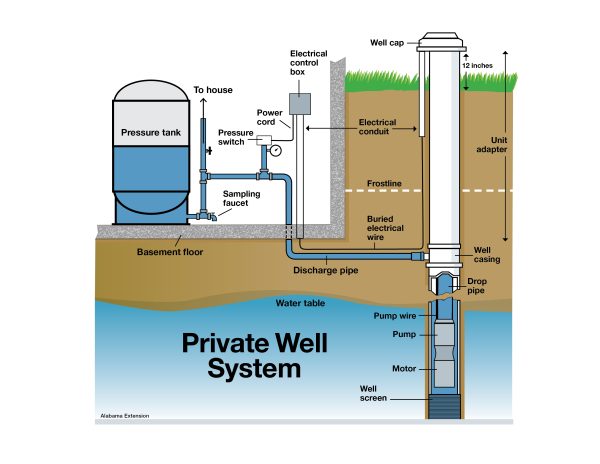 Project Lead: Jessica Curl, Eve Brantley
Project Lead: Jessica Curl, Eve Brantley
Background: The Alabama Private Well Program was established in 2020 and has since become a highly valued and referenced resource to both Alabama Extension clients and staff across the state. This program increases access to private well educational materials to empower, engage, and equip well users with the resources needed to protect their water systems.
The core values of the program are to deliver meaningful information to homeowners with private wells, educate well owners on the importance of proper well stewardship, and serve as a resource for well owners and Extension personnel to obtain answers and information.
After launching a collection of newly developed resources to Extension offices in early 2021, the program saw an opportunity to enhance educational efforts by supplementing printed materials with interactive training. This led to the creation of a comprehensive well water webinar series offered biweekly and available to Extension administrative staff, county Extension coordinators, regional Extension agents, and specialists.
Agency Collaborators: Alabama Department of Public Health, Geological Survey of Alabama
Evaluation Technique: Direct consultation and evaluation survey
Impact Estimates:
Hosted 7 virtual Lunch and Learn webinars featuring 4 guest speakers with participant representation from industries, agencies, and universities. 80 participants engaged in the webinar series.
Connected with the Alabama Department of Public Health to provide Well Water Resource Packets to each ADPH county office & each Alabama Extension office.
Published 20 content pieces on the Extension website. Program featured in 2 blog posts.
Assisted in 10+ engagements.
Published 2 technical digital publications.
Established a recognizable brand.
Connected with Extension Well Water Programs at 8 different universities.
Produced 1 educational video with Extension Communications and Marketing.
Worked with Extension Communications and Marketing to develop an online continuing education course and well owner’s handbook (set for release in Fall 2022).
“I have really retained a lot of knowledge from the well water [lunch and learn] sessions. Great job to you and your team!”
“Just wanted to thank you for the good job with this series. Good basic information, keep up the good work!”
“Going to the ACES website, I was particularly impressed with the posted Alabama Private Well Program resources. They are very well done and provide a new dimension to the AU Water Resources Center’s reach across the state.”
“Great program and received reliable education.”
Alabama Water Watch: Community-Based, Science-Based Volunteer Water Monitoring of Alabama’s Water Resources.
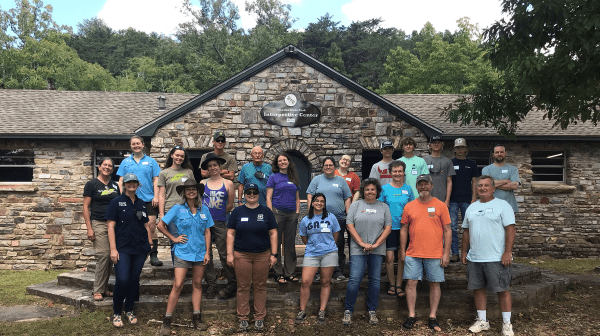 Project Team: Eve Brantley, Mona Dominguez, Sergio Ruiz-Córdova, Sydney Zinner, Rachel McGuire, and Carolina Ruiz
Project Team: Eve Brantley, Mona Dominguez, Sergio Ruiz-Córdova, Sydney Zinner, Rachel McGuire, and Carolina Ruiz
Background: The focus of Alabama Water Watch (AWW) is promoting community-based, science-based, volunteer water monitoring to residents throughout the state. In 2021, AWW awarded 334 certifications to individuals in water chemistry and bacteriological monitoring. AWW reached an additional 353 people through webinars, a virtual annual meeting, and data interpretation sessions via Zoom. Although AWW’s ability to engage new volunteers was limited due to COVID-19, monitors submitted a total of 3,651 water data records.
In 2021, AWW completed the development of three self-paced online courses: (1) Introduction to Alabama Water Watch, (2) Water Chemistry Monitoring, and (3) Bacteriological Monitoring. Each course consists of modules that include videos and quizzes related to course content. Future AWW training will be offered in a hybrid model with online and in-person components.
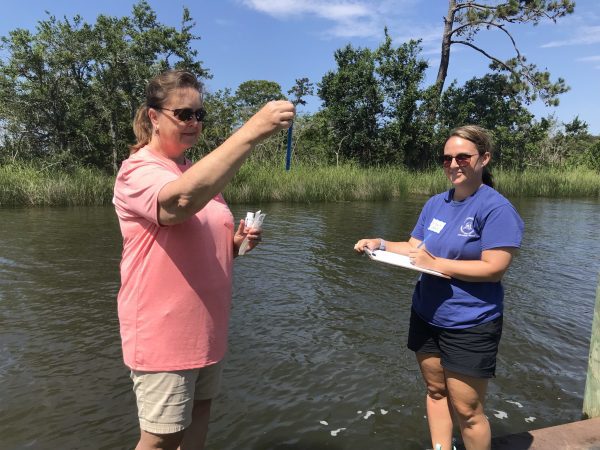 The creation of the AWW online courses addresses challenges to in-person meetings that have been presented by the pandemic. They also address some long-term program challenges related to AWW’s reach, as many potential volunteers have been excluded from AWW training workshops because of scheduling conflicts and time constraints. AWW hopes that these changes will make it possible for a wider audience to participate in the future.
The creation of the AWW online courses addresses challenges to in-person meetings that have been presented by the pandemic. They also address some long-term program challenges related to AWW’s reach, as many potential volunteers have been excluded from AWW training workshops because of scheduling conflicts and time constraints. AWW hopes that these changes will make it possible for a wider audience to participate in the future.
Collaborators: In 2021, AWW continued to grow its network of collaborators that include NOAA, USDA USFS, EPA, ADEM, Wild Alabama, Cheaha State Park, various municipalities, storm water management entities, and universities. AWW also works to increase its visibility with Extension staff throughout the state.
Number of Participants: 678
Evaluation Technique: Analysis of volunteer monitor data submitted to the AWW database.
Impact Estimates:
Volunteers spent 16,855 hours (valued at $481,042) participating in training, webinars, and data interpretation sessions as well as collecting 3,651 water data records.
The 3,651 data records collected by AWW volunteer monitors will be included in the Alabama Department of Environmental Management’s 305(b) Water Quality Report to Congress and used to determine if water bodies are meeting water quality standards. This amount of data would cost ADEM over $680,000 to collect.
AWW continued collaboration with the USDA Forest Service to support a network of volunteer water monitors in National Forests in Alabama (NFAL). This project expanded to the Talladega National Forest. Project volunteers submitted 144 water data records collected from water bodies within NFAL priority watersheds identified through the USFS’s Watershed Condition Framework.
39 articles were published on the AWWareness blog and shared on AWW social media.
The AWWareness e-newsletter was distributed monthly to approximately 3,700 subscribers.
Return on Investment: 56:1
4-H Alabama Water Watch
Background: The goal of 4-H AWW is to provide educators, including teachers, volunteers, and 4-H agents, with the training, materials, and support they need to engage students in water quality monitoring and watershed stewardship in their communities. Participating students will be prepared to make informed and responsible decisions about their environment and will explore related career paths.
Approximately 50 students completed the AWW general evaluation. Their responses generally indicated that students gained an appreciation for Alabama’s water resources. Students also were able to make the connection between human activities on the land and water pollution. In the survey, 60% of the students changed their response regarding whether they “know what a watershed is and the name of my watershed” from “strongly disagree” or “disagree” to “agree” or “strongly agree” following their participation in a 4-H AWW activity. Understanding the concept of a watershed is fundamental to making the connection between land-based activities and water pollution. Being able to identify one’s own watershed can increase the connection students feel to their local water resources.
Number of Participants: 870 youth
Evaluation Technique: Enrollment reports from the 4HOnline System and analysis of pre- and post-tests submitted by 4-H regional Extension agents.
Impact Estimates:
4-H AWW Staff supported Winston and Walker County Extension staff as they certified 37 4-H’ers as water chemistry monitors.
16 Extension employees who conduct 4-H AWW activities received new or replacement equipment for monitoring.
4-H AWW groups submitted 53 water data records to the AWW database.
Developed new curriculum, Exploring Pathogen Pollution in Our Waters (EOW), as a companion guide to the existing Alabama Water Watch Bacteriological Monitoring Manual. Curriculum development was part of the NOAA BWET grant-funded project.
Trained 27 educators to conduct 4-H AWW programming.
Partnered with the Alabama Watershed Stewards Program to train 50 Extension employees who conduct 4-H to lead anti-litter campaigns in their counties.
New April 2022, Aquatic Resources: Activities & Impacts 2021, ANR-2868

